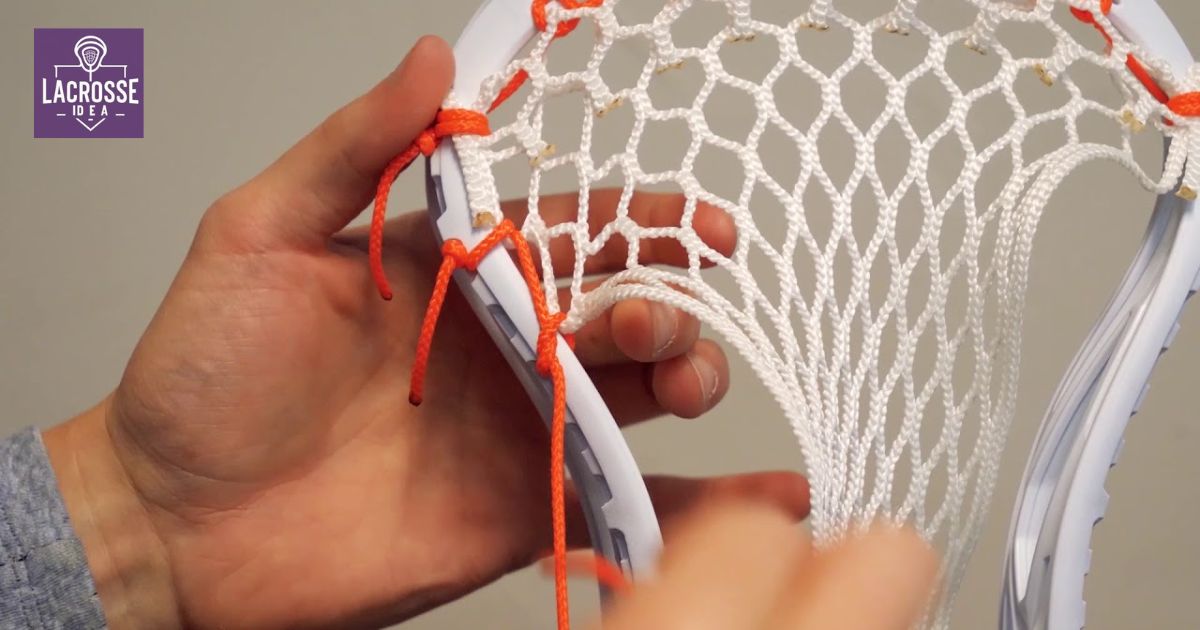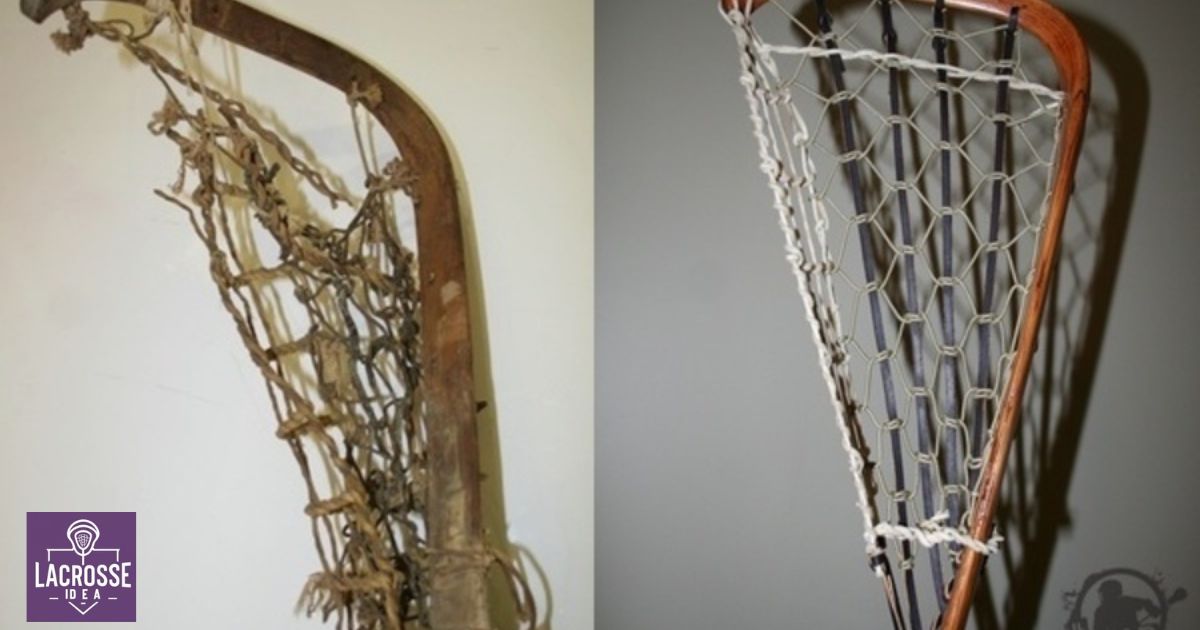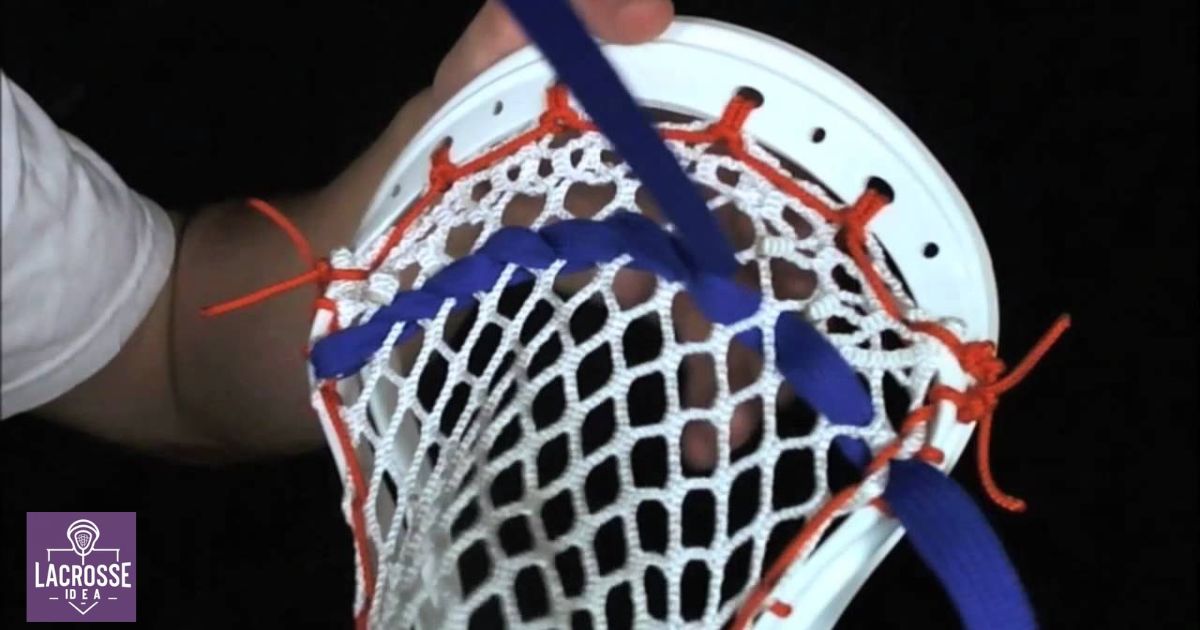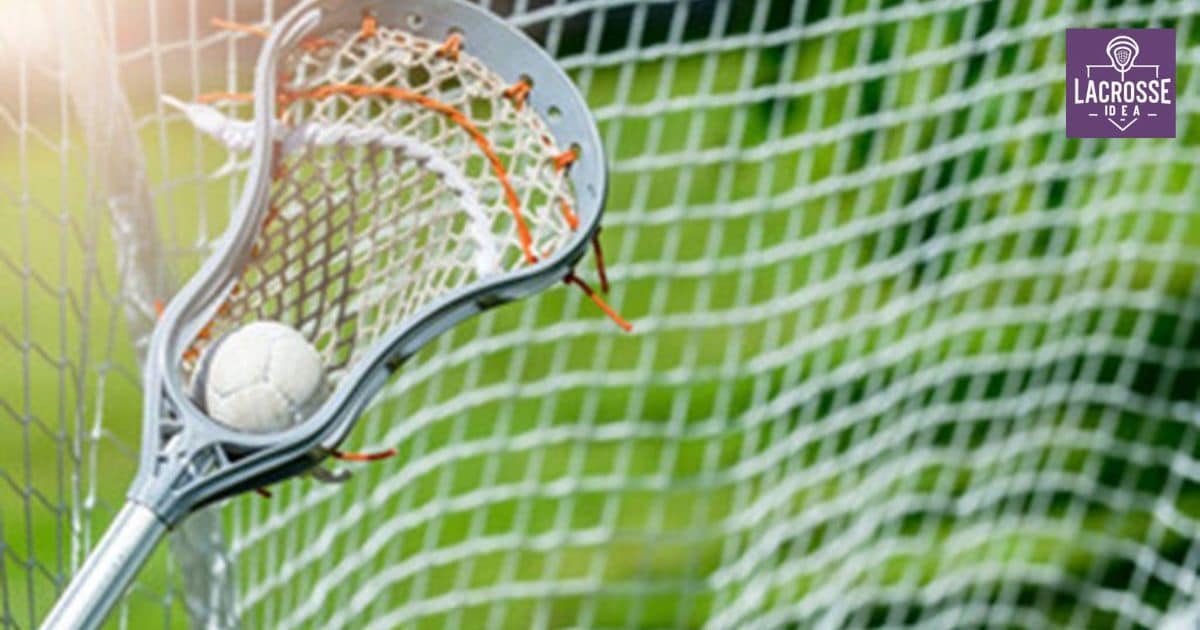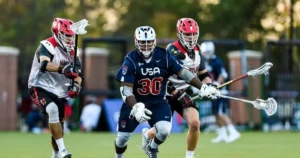Are you tired of fumbling with a loose, ineffective lacrosse net? Look no further! In this comprehensive guide, we will walk you through the art of stringing a lacrosse net with finesse and precision. From selecting the right mesh to troubleshooting tips, you’ll learn all the essential techniques to create a net that guarantees optimal performance. So, grab your lacrosse head, get ready to dive into the world of lacrosse stringing, and join the ranks of skilled net enthusiasts.
Key Takeaways
- Different types of lacrosse mesh available, such as soft mesh and hard mesh, offer different pocket characteristics.
- Inspect the lacrosse head for signs of wear and make necessary repairs or replace the head if needed.
- Customize the lacrosse head for an enhanced playing experience by adding sidewall holes and creating a custom shooting string setup.
- Maintain and store the lacrosse net properly to prevent damage, including cleaning it regularly and storing it in a cool, dry place.
Select The Right Lacrosse Mesh
To ensure optimal performance and durability, it is crucial to carefully select the appropriate lacrosse mesh for stringing your lacrosse net. Choosing the right lacrosse mesh is essential as it can greatly impact your playing style and overall experience on the field. There are different types of lacrosse mesh available, each with its own unique characteristics and benefits. For example, soft mesh provides a more forgiving pocket and is ideal for players who prefer a smooth release, while hard mesh offers a stiffer pocket and is preferred by those who value accuracy and consistency.
Additionally, there are stringing techniques specifically designed for different playing styles, such as high pocket, low pocket, or mid pocket. By understanding your playing style and considering the different mesh options, you can select the perfect lacrosse mesh that suits your needs. Now, let’s transition into the subsequent section about how to prepare your lacrosse head.
Prepare Your Lacrosse Head
To ensure a successful stringing process, it is vital to properly prepare your lacrosse head before beginning the stringing process. Lacrosse head maintenance is crucial for the longevity and performance of your equipment. Before you start stringing, inspect your lacrosse head for any signs of wear, such as cracks or loose screws. If any damage is present, make the necessary repairs or consider replacing the head altogether.
Additionally, lacrosse head customization can enhance your playing experience. You can choose to add sidewall holes for more string options or create a custom shooting string setup to optimize your shot accuracy. By taking the time to properly maintain and customize your lacrosse head, you can enhance your performance on the field and prolong the lifespan of your equipment.
Start The Top String
Begin by selecting a suitable length of top string for your lacrosse net. The top string plays a crucial role in maintaining the shape and tension of the net, so it is essential to choose the right material. Nylon or polyester strings are commonly used due to their durability and resistance to weather conditions.
Once you have selected the material, start by tying off the top string at one end of the net. Make a loop at the end of the string, then pass it through the first hole in the sidewall of the lacrosse head. Pull the string tight, ensuring that it is secure. Repeat this process for each hole along the top of the head until the entire top string is tied off securely.
String The Sidewall
Continuing from securing the top string, proceed to stringing the sidewall of the lacrosse net using a professional style of writing. The sidewall plays a crucial role in maintaining the tension of the net and ensuring a consistent pocket. To achieve the desired sidewall tension, it is important to utilize effective sidewall knot techniques. Start by threading the sidewall string through the sidewall holes, alternating between the front and back sides of the head.
Pull the string tightly, but not excessively, to maintain proper tension. To secure the string, use sidewall knot techniques such as the double knot or the interlock knot. These techniques ensure that the sidewall string stays in place and maintains the desired tension throughout gameplay. Mastering these sidewall knot techniques will contribute to a well-constructed lacrosse net that enhances performance and provides a sense of belonging to the sport.
Create The Shooting Strings
Now that the sidewall has been properly strung, it is time to create the shooting strings, which play a crucial role in the accuracy and power of a lacrosse shot. The placement of the shooting strings is important, as they help control the release of the ball. Selecting the right material for the shooting strings and adjusting their tension are also key factors in achieving the desired shooting performance.
Proper Shooting String Placement
To properly create the shooting strings for your lacrosse net, begin by carefully placing them using a pre-determined pattern. Proper shooting string placement is crucial for achieving accuracy and power in your shots. Here are three key points to consider when placing your shooting strings:
- Consistency: Ensure that the shooting strings are evenly spaced and aligned. Consistency in string placement will provide a predictable release point, allowing you to develop muscle memory and improve your shooting technique.
- Tension: Adjust the tension of the shooting strings to your preference. A tighter shooting string will generate more whip and power, while a looser string will provide a quicker release. Experiment with different tensions to find what works best for you.
- Avoid common mistakes: Be mindful of common shooting string mistakes, such as placing them too close to the sidewall or having them too loose. These errors can negatively impact your shot accuracy and consistency.
Selecting Shooting String Material
When creating the shooting strings for your lacrosse net, it is important to carefully select the material that will be used. Choosing the right shooting string material can greatly impact your performance on the field. There are different types of shooting strings available, each with its own unique characteristics. Below is a table that outlines three common types of shooting string material:
| Material | Description | Advantages |
|---|---|---|
| Nylon | Durable and weather-resistant material | Provides consistency and control |
| Cotton | Soft and flexible material | Offers a smooth release and enhanced feel |
| Wax-Coated | Stiff and water-resistant material | Adds stability to your shots and prevents moisture buildup |
Adjusting Shooting String Tension
Once you have selected the appropriate shooting string material, it is important to adjust the tension of the shooting strings to ensure optimal performance. Here are three key points to consider when adjusting the tension of your shooting strings:
- Importance of shooting string placement: The placement of your shooting strings can greatly impact your shot accuracy and power. By adjusting the tension of the shooting strings, you can control the release of the ball, allowing for a more consistent and controlled shot.
- Different types of shooting string materials: There are various shooting string materials available, such as nylon, cotton, or waxed string. Each material offers different levels of grip and feel on the ball. By experimenting with different materials and tension levels, you can find the combination that suits your playing style and preferences.
- Fine-tuning your shooting string tension: Adjusting the tension of your shooting strings is a personal preference. Some players prefer a tighter tension for increased power, while others prefer a looser tension for improved ball control. It is important to experiment and find the tension that feels comfortable and allows you to perform at your best.
Tie Off The Bottom String
The bottom string of the lacrosse net should be securely tied using a professional technique. This ensures that the net stays in place and maintains its shape during gameplay. To tie off the bottom string, start by threading the string through the last sidewall hole and make a loop. Then, pass the end of the string through the loop and pull it tight.
This creates a secure knot that prevents the string from slipping or coming undone. Adjust the tension of the bottom string by pulling it firmly, but not too tight, to maintain the desired level of pocket depth. This will allow for optimal ball control and accuracy when shooting. Now that the bottom string is securely tied, it’s time to move on to adjusting the tension and shape of the net.
Adjust The Tension And Shape
To achieve the desired tension and shape of the lacrosse net, carefully manipulate the strings using precise adjustments. Follow these steps to ensure that your net is perfectly tensioned and maintains its shape:
- Adjust the sidewall strings: Start by tightening or loosening the sidewall strings to create an even tension across the net. This will help maintain the shape and prevent any sagging in the middle.
- Tweak the shooting strings: Make small adjustments to the shooting strings to fine-tune the tension. This will allow for a consistent release and accurate shots.
- Check the top string: Ensure that the top string is properly tensioned and centered. This will provide stability and help maintain the overall shape of the net.
Maintain And Care For Your Net
When it comes to maintaining and caring for your lacrosse net, there are a few key points to keep in mind. Proper storage techniques are essential to prevent damage and prolong the lifespan of the net. Regular cleaning and maintenance, such as removing debris and repairing any tears, can help ensure optimal performance. Additionally, taking proactive steps to prevent wear and tear, such as avoiding excessive exposure to sunlight and harsh weather conditions, can help maintain the net’s durability over time.
Proper Storage Techniques
How can you effectively maintain and care for your lacrosse net to ensure its longevity? Proper storage techniques are essential for preventing damage to your net. Here are three crucial steps to follow:
- Clean and dry: Before storing your net, make sure to remove any dirt or debris by gently brushing it off. Allow the net to dry completely to prevent mold or mildew growth.
- Fold and roll: Carefully fold the net in a neat and compact manner. Start from one end and roll it tightly, ensuring that there are no creases or tangles. This will help maintain the net’s shape and prevent any unnecessary wear and tear.
- Store in a dry place: Find a cool and dry location to store your net, away from direct sunlight or extreme temperatures. Avoid placing heavy objects on top of it, as this can cause permanent damage.
Cleaning And Maintenance Tips
Properly maintaining and caring for your lacrosse net is vital for its longevity, and implementing regular cleaning and maintenance practices is essential. To keep your net in top condition, it is important to use appropriate lacrosse net cleaning products. These specialized products are designed to remove dirt, debris, and sweat that can accumulate on the net over time.
Regular cleaning not only helps to maintain the appearance of your net but also prevents the buildup of bacteria and odors. Additionally, it is important to establish a lacrosse net maintenance schedule. This schedule should include regular inspections to check for any damage or wear and tear that may require repairs. By following these cleaning and maintenance tips, you can ensure that your lacrosse net remains in excellent condition and ready for play.
Preventing Wear And Tear
To properly maintain and care for your lacrosse net, it is important to implement preventative measures to prevent wear and tear. By taking these steps, you can prevent fraying and extend the lifespan of your net, ensuring that it remains in optimal condition for longer periods of time. Here are three key measures you can take:
- Regularly inspect your net: Check for any signs of fraying or damage. Repair any small tears or loose strings immediately to prevent further deterioration.
- Store your net properly: When not in use, make sure to store your net in a cool, dry place. Avoid exposing it to extreme temperatures or moisture, as these can weaken the net fibers.
- Use protective equipment: When playing, make sure to wear appropriate gear, such as gloves and padding. This not only protects you but also reduces the likelihood of excessive strain on the net.
Troubleshooting Tips
One useful approach for addressing common issues when stringing a lacrosse net involves utilizing specific techniques and adjustments. Troubleshooting lacrosse net stringing can help players avoid common stringing mistakes, ensuring a properly tensioned and functional net. Here are some troubleshooting tips to keep in mind:
| Issue | Possible Solution |
|---|---|
| Loose shooting strings | Retie shooting strings tightly |
| Uneven pocket | Adjust sidewall strings for consistent tension |
| Mesh catching on sidewalls | Realign mesh and adjust sidewall tension |
| Inconsistent release | Realign shooting strings and adjust tension |
| Excessive bagging | Tighten top strings and adjust sidewall tension |
Frequently Asked Questions
Can I Use Any Type of Lacrosse Mesh for Stringing My Lacrosse Net?
Yes, there are different types of lacrosse mesh available for stringing a lacrosse net. Each type has its own pros and cons, so it’s important to consider factors such as durability, performance, and personal preference when choosing the right mesh for your net.
How Do I Know if My Lacrosse Head Is Properly Prepared for Stringing?
Proper head maintenance is crucial for lacrosse players to ensure optimal performance. By identifying common stringing mistakes in the lacrosse net, players can avoid issues such as loose knots and uneven tension, resulting in a more consistent and effective game.
What Is the Purpose of the Shooting Strings in a Lacrosse Net?
Shooting strings in a lacrosse net serve the purpose of enhancing shooting accuracy. By providing additional control and stability to the ball, these strings contribute to a player’s ability to aim and score with precision.
How Do I Adjust the Tension and Shape of My Lacrosse Net After Stringing?
To ensure optimal performance, it is crucial to adjust the tension and maintain the shape of your lacrosse net after stringing. Properly adjusting tension ensures a consistent rebound, while maintaining shape enhances accuracy and shot control.
What Are Some Common Troubleshooting Tips for Fixing Issues With a Lacrosse Net?
When encountering issues with a lacrosse net, troubleshooting tips can help fix common problems. By following these tips, you can address issues and ensure the net is in optimal condition for a successful game.
Conclusion
In conclusion, stringing a lacrosse net requires careful selection of mesh, preparation of the lacrosse head, and proper stringing techniques. Maintaining and caring for the net is also important. One interesting statistic is that lacrosse is one of the fastest-growing sports in the United States, with a 218% increase in youth participation from 2001 to 2017.
